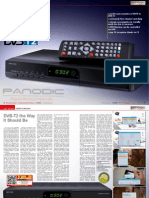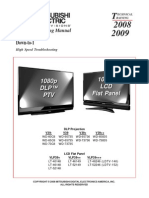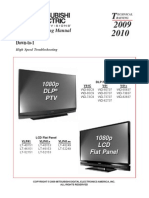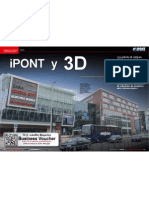0 ratings0% found this document useful (0 votes)
35 viewsFeature Uhdtv
Feature Uhdtv
Uploaded by
Alexander WieseUltra High Definition Television (UHDTV) has significantly higher resolution than HDTV, with 4K UHDTV having 4 times and 8K UHDTV having 16 times the resolution of HDTV. UHDTV also supports wider color spaces for more natural colors and higher frame rates up to 120 frames per second for improved 3D video. However, UHDTV requires much greater bandwidth for transmission and many supporting technologies and standards still need to be developed to fully realize UHDTV. While UHDTV faces challenges, its higher quality pictures will likely become widely available over time as technologies advance.
Copyright:
Attribution Non-Commercial (BY-NC)
Available Formats
Download as PDF, TXT or read online from Scribd
Feature Uhdtv
Feature Uhdtv
Uploaded by
Alexander Wiese0 ratings0% found this document useful (0 votes)
35 views2 pagesUltra High Definition Television (UHDTV) has significantly higher resolution than HDTV, with 4K UHDTV having 4 times and 8K UHDTV having 16 times the resolution of HDTV. UHDTV also supports wider color spaces for more natural colors and higher frame rates up to 120 frames per second for improved 3D video. However, UHDTV requires much greater bandwidth for transmission and many supporting technologies and standards still need to be developed to fully realize UHDTV. While UHDTV faces challenges, its higher quality pictures will likely become widely available over time as technologies advance.
Copyright
© Attribution Non-Commercial (BY-NC)
Available Formats
PDF, TXT or read online from Scribd
Share this document
Did you find this document useful?
Is this content inappropriate?
Ultra High Definition Television (UHDTV) has significantly higher resolution than HDTV, with 4K UHDTV having 4 times and 8K UHDTV having 16 times the resolution of HDTV. UHDTV also supports wider color spaces for more natural colors and higher frame rates up to 120 frames per second for improved 3D video. However, UHDTV requires much greater bandwidth for transmission and many supporting technologies and standards still need to be developed to fully realize UHDTV. While UHDTV faces challenges, its higher quality pictures will likely become widely available over time as technologies advance.
Copyright:
Attribution Non-Commercial (BY-NC)
Available Formats
Download as PDF, TXT or read online from Scribd
Download as pdf or txt
0 ratings0% found this document useful (0 votes)
35 views2 pagesFeature Uhdtv
Feature Uhdtv
Uploaded by
Alexander WieseUltra High Definition Television (UHDTV) has significantly higher resolution than HDTV, with 4K UHDTV having 4 times and 8K UHDTV having 16 times the resolution of HDTV. UHDTV also supports wider color spaces for more natural colors and higher frame rates up to 120 frames per second for improved 3D video. However, UHDTV requires much greater bandwidth for transmission and many supporting technologies and standards still need to be developed to fully realize UHDTV. While UHDTV faces challenges, its higher quality pictures will likely become widely available over time as technologies advance.
Copyright:
Attribution Non-Commercial (BY-NC)
Available Formats
Download as PDF, TXT or read online from Scribd
Download as pdf or txt
You are on page 1of 2
FEATURE
Ultra High Definition Television
puede mostrar ms colores, principalmente rojo y tonos verdes apto para 3D, debido a su mayor velocidad de cuadro requiere un ancho de banda enorme los usuarios necesitan equipos estrenar como TVEAD no es compatible con versiones anteriores
162 TELE-audiovision International The Worlds Largest Digital TV Trade Magazine 09-10/2013 www.TELE-audiovision.com
www.TELE-audiovision.com 09-10/2013 TELE-audiovision International
163
FEATURE
Ultra High Definition Television
Whats behind the new standard? Is it even a standard?
Jacek Pawlowski
We all are familair with High Definition Television. HDTV uses picture resolutions of either 720p, 1080i or 1080p. The first two are used for broadcasting TV via satellites while the last one is mostly used with Blu-ray discs. A HDTV video signal has either 50 or 60 picture frames per second. If a complete picture is sent in every frame, the letter p is added after the resolution figure (720p or 1080p). If only half the horizontal lines are sent in one frame (only odd number lines, then only even number lines and so on), the letter i depicts such interlaced video. Most of the contemporary satellite TV receivers upscale any 720p or 1080i video signals to 1080p and then output the video to your living room TV. Now, if we focus on the best version of HDTV 1080p it has a picture resolution of 1920 x 1080. The new 4K UHDTV standard has doubled the resolution in both axes to 3840 2160 while the 8K UHDTV has even quadrupled it: 7680 4320. The best way to realize how big an improvement UHDTV introduces is to look at our simple picture showing TV screens for different standards but the same pixel size (see picture). Imagine this: 4K is like arranging 4 HD TV-sets in a 2x2 array, while for 8K UHDTV one would need 8 HD TVs arranged in a 4x4 array! Though resolution is the most obvious improvement over classical HDTV it is by no means the only parameter that has been changed. The other two related to video are: color space and frame rate. UHDTV has a wider color space than HDTV. In particular, UHDTV picture is able to reproduce more deeply red and more deeply green colors which can not be shown by our existing HDTV equipment. In this way, UHDTV is able to reproduce more natural colors. The standard extends the allowable frame rates up to 120 frames per second. In this way 3D video can be reproduced with up to 60 fps for each eye. 60 fps are typical for North American TV whilst 50
Comparison of the TV screens for different resolution standards.
fps is used in most other areas including Europe. Therefore European 3D TV will use 100 fps rather than 120 fps. Adding to these enormous improvements in video performance, UHDTV also expanded the audio quality. With the new UHDTV standard an astounding 22 audio channels plus 2 low frequency effects channels are possible. The 22 channels are divided into three groups: an upper layer of nine channels, a middle layer of ten channels and a lower layer of three channels. Such complex audio setups can be found at movie theatres and thus with UHDTV this also becomes available to the average viewer. Of course, the first thing in order to enjoy that big resolution is a UHDTV compliant TV monitor. The best TV manufacturers already offer 4K UHDTV TV-sets with large screen (70 or more). Monitors capable of showing 8K can be seen at the professional broadcasting exhibitions but sofar we know of no such monitor available at regular stores. Now, what about the sources of ultra HD video? Presently, the choice is extremely small. One model of UHDTV video player has been announced with a few pre-stored movies in 4K format on the internal HDD. Blu-ray Disc Association have just started their work on extending Blu-Ray Disc specification to include 4K Ultra HD video. Similarly, Sony announced that their PlayStation 4 will support 4K resolution but only for photos and videos not for the games themselves. And what is going on in the satellite industry? In Europe EUTELSAT has started 4K UHD test transmissions coded with the MPEG-4 codec on EUTELSAT 10A. Quite recently, SES has done one step further and started a 4K channel coded with the newest HEVC (H.265) codec that helped reducing the necessary bitrate down to 20 Mbit/sec. You do not have to be an expert to realize that 4K UHDTV requires 4 times more bits than HDTV and 8K UHDTVrequires 16 times more bits. This is really a problem because the communication networks have finite throughput rates. HEVC, known also as H.265, can help here as its efficiency is roughly 2 times better than MPEG 4. But even using the best available codec you still need about 20 Mbit/sec for 4K UHDTV and as much as 80 Mbits/sec to broadcast a single channel. And all this for 50/60 fps. If you liked to double the frame rate to 100/120 to transmit 3D UHDTV you would need twice the bandwidth. It is funny to think that if in the future 8K is introduced to satellite broadcast, one transponder will be carrying a maximum one channel like in the old days of analog TV. The list of devices and standards that still have to be developed or extended is long: UHDTV cameras and other studio equipment, HDMI interface, audio equipment, and, of course, all kinds of digital TV receivers: satellite, cable, IPTV and (maybe) terrestrial. New equipment will require new chip-sets and perhaps even new hardware architecture to do the job efficiently. UHDTV is not backward compatible with HDTV. In other words, your present HDTV receiver will not process a UHDTV channel. Naturally, in the beginning, there will be a scarcity of ultra high resolution programs and many UHDTV channels will be created by up-scaling regular HDTV. We can still remember the first years of HDTV or more recently 3D HDTV the same will happen with UHDTV. However, despite all the technology, communication and media problems linked with UHDTV, we strongly believe that the race has started for good and sooner or later we will all enjoy the wonderful ultra high definition pictures in our houses.
164 TELE-audiovision International The Worlds Largest Digital TV Trade Magazine 09-10/2013 www.TELE-audiovision.com
You might also like
- Service Manual: LC-60LE632U LC-70LE732UDocument184 pagesService Manual: LC-60LE632U LC-70LE732Utonyroguez50100% (1)
- Feature UhdtvDocument2 pagesFeature UhdtvAlexander WieseNo ratings yet
- Feature UhdtvDocument2 pagesFeature UhdtvtelesatelliteporNo ratings yet
- Feature UhdtvDocument2 pagesFeature UhdtvAlexander WieseNo ratings yet
- Feature UhdtvDocument2 pagesFeature UhdtvAlexander WieseNo ratings yet
- Feature UhdtvDocument2 pagesFeature UhdtvAlexander WieseNo ratings yet
- Feature UhdtvDocument2 pagesFeature UhdtvAlexander WieseNo ratings yet
- Feature UhdtvDocument2 pagesFeature UhdtvAlexander WieseNo ratings yet
- Feature UhdtvDocument2 pagesFeature UhdtvAlexander WieseNo ratings yet
- Feature UhdtvDocument2 pagesFeature UhdtvAlexander WieseNo ratings yet
- Feature UhdtvDocument2 pagesFeature UhdtvAlexander WieseNo ratings yet
- Feature UhdtvDocument2 pagesFeature UhdtvAlexander WieseNo ratings yet
- Feature UhdtvDocument2 pagesFeature UhdtvAlexander WieseNo ratings yet
- Feature UhdtvDocument2 pagesFeature UhdtvAlexander WieseNo ratings yet
- Ultra HD Via Satellite: Key Features of The New Demonstration Channel ON HOT BIRD (13° East)Document2 pagesUltra HD Via Satellite: Key Features of The New Demonstration Channel ON HOT BIRD (13° East)Florin NicolaNo ratings yet
- 4K Resolution: The Future of ResolutionsDocument15 pages4K Resolution: The Future of ResolutionsRavi JoshiNo ratings yet
- Ultra HDDocument4 pagesUltra HDJanna WilsonNo ratings yet
- HD & HDTV: PAL NTSC 576i (Digital PAL) 480i (Digital NTSC) S Resolution Frame Rate Aspect RatiosDocument9 pagesHD & HDTV: PAL NTSC 576i (Digital PAL) 480i (Digital NTSC) S Resolution Frame Rate Aspect Ratioscr0zzb0wNo ratings yet
- High Definition TelevisionDocument40 pagesHigh Definition TelevisionMousum Dutta100% (1)
- Questions & AnswersDocument3 pagesQuestions & AnswersJaimichu07No ratings yet
- HDTVDocument22 pagesHDTVkprk414No ratings yet
- Beginning With IPBox 9xxxHD 120609 enDocument56 pagesBeginning With IPBox 9xxxHD 120609 enArnold StirlitzNo ratings yet
- Alem Do HDTVDocument22 pagesAlem Do HDTVFabio ArpNo ratings yet
- GR HK 2007 IntDocument39 pagesGR HK 2007 IntpokornypvlNo ratings yet
- High Definition VideoDocument1 pageHigh Definition VideorocountNo ratings yet
- Beginners Guide For 9xxxHD Series 231208 enDocument37 pagesBeginners Guide For 9xxxHD Series 231208 enelgeneral-forokeys7539100% (5)
- HDTVDocument2 pagesHDTVRegine Kaye TagurdaNo ratings yet
- Toshiba Guía U77Document2 pagesToshiba Guía U77Lopez OmarNo ratings yet
- HD TV Made Easy WorkshopDocument47 pagesHD TV Made Easy WorkshopJohnNo ratings yet
- SLIDEDocument15 pagesSLIDEPritesh SapariaNo ratings yet
- DigitaltvamitDocument15 pagesDigitaltvamita_mitNo ratings yet
- Delivering Quality Ultra HDDocument12 pagesDelivering Quality Ultra HDEdward CallowNo ratings yet
- SES Ultra HD 4KDocument8 pagesSES Ultra HD 4KJaimichu07No ratings yet
- The New HEVC/H.265 Standard: FEATURE Ultra High DefinitionDocument2 pagesThe New HEVC/H.265 Standard: FEATURE Ultra High DefinitionAlexander WieseNo ratings yet
- High Definition TV: Audio-Video SystemsDocument4 pagesHigh Definition TV: Audio-Video SystemsAtit PatelNo ratings yet
- First-Class in Every Sense.: Sound & Vision 2011 - 2012Document27 pagesFirst-Class in Every Sense.: Sound & Vision 2011 - 2012Razvan BaraganNo ratings yet
- 4k - Consumer-Whitepaper FINAL (As)Document6 pages4k - Consumer-Whitepaper FINAL (As)jcmendez506No ratings yet
- De La Standard TV A La Nueva Super High Vision TVDocument17 pagesDe La Standard TV A La Nueva Super High Vision TVJuan PerezNo ratings yet
- PVI VeCoax HDMI To QAM HD Modulator With IPTV Stream SpecificationsDocument6 pagesPVI VeCoax HDMI To QAM HD Modulator With IPTV Stream SpecificationsDavid WardNo ratings yet
- HDTV T: EchnologyDocument26 pagesHDTV T: EchnologyDivya KrishnanNo ratings yet
- TV Broadcasting Part 2Document61 pagesTV Broadcasting Part 2Mikaela Dela CruzNo ratings yet
- PanodicDocument5 pagesPanodicAlexander WieseNo ratings yet
- PanodicDocument5 pagesPanodicAlexander WieseNo ratings yet
- Camarig, Kinjie D. Btled Iii-1 Learning Assessment 1. Name Analog Video FormatsDocument3 pagesCamarig, Kinjie D. Btled Iii-1 Learning Assessment 1. Name Analog Video FormatsKIN JIENo ratings yet
- PP PCTV Quatro Stick (510e) enDocument2 pagesPP PCTV Quatro Stick (510e) enStarLink1No ratings yet
- Philips 40pfl3706 40pfl3706 f7 Manual de UsuarioDocument3 pagesPhilips 40pfl3706 40pfl3706 f7 Manual de UsuarioAbelardoNo ratings yet
- V39-VLP39 Training ManualDocument84 pagesV39-VLP39 Training ManualtechtvserviceincNo ratings yet
- The Road To UHDTV: in 2020 Everyone Will Have It Until Then, There's Much Work To DoDocument12 pagesThe Road To UHDTV: in 2020 Everyone Will Have It Until Then, There's Much Work To DoPedro Antonio González EspinozaNo ratings yet
- LGSV09Document85 pagesLGSV09Santi HandayaniNo ratings yet
- Ultra-High-Definition TelevisionDocument11 pagesUltra-High-Definition TelevisionYiddam QuiriarteNo ratings yet
- Emerging Technologies in BroadcastingDocument44 pagesEmerging Technologies in BroadcastingYashank JainNo ratings yet
- Test 3 SkjaDocument4 pagesTest 3 Skjasalva15regNo ratings yet
- Akai Lct3285taDocument2 pagesAkai Lct3285taOscar Andres Quiceno BuitragoNo ratings yet
- Nick Davies 21 1Document11 pagesNick Davies 21 1api-337613910No ratings yet
- V41-VLP41 Training ManualDocument80 pagesV41-VLP41 Training ManualDan PrewittNo ratings yet
- High Definition TelevisionDocument11 pagesHigh Definition TelevisionNitin PanchalNo ratings yet
- Colour Banding: Exploring the Depths of Computer Vision: Unraveling the Mystery of Colour BandingFrom EverandColour Banding: Exploring the Depths of Computer Vision: Unraveling the Mystery of Colour BandingNo ratings yet
- How to Get Rid of Cable TV & Save Money: Watch Digital TV & Live Stream Online MediaFrom EverandHow to Get Rid of Cable TV & Save Money: Watch Digital TV & Live Stream Online MediaRating: 5 out of 5 stars5/5 (1)
- Chromecast Device User Guide: Chromecast TV Device Setup and User ManualFrom EverandChromecast Device User Guide: Chromecast TV Device Setup and User ManualNo ratings yet
- Global in Va ComDocument8 pagesGlobal in Va ComAlexander WieseNo ratings yet
- Grande O Pequeño Elnet Lo Tiene Todo: Elnet Mayorista Y Minorista de TV Digital, Islandia Informe de CompañíaDocument4 pagesGrande O Pequeño Elnet Lo Tiene Todo: Elnet Mayorista Y Minorista de TV Digital, Islandia Informe de CompañíaAlexander WieseNo ratings yet
- Horizon HD-CM+ Para: Medidor de Señal DVB-C Informe de PruebaDocument5 pagesHorizon HD-CM+ Para: Medidor de Señal DVB-C Informe de PruebaAlexander WieseNo ratings yet
- Ab Ipbox Prismcube Ruby: Receptor de Satélite HDTV PVR Con Centro Multimedia Informe de PruebaDocument8 pagesAb Ipbox Prismcube Ruby: Receptor de Satélite HDTV PVR Con Centro Multimedia Informe de PruebaAlexander WieseNo ratings yet
- Speedcast: Speedcast Enlace de Subida de Satelite, Barueri, SP, Brasil Informe de CompañíaDocument8 pagesSpeedcast: Speedcast Enlace de Subida de Satelite, Barueri, SP, Brasil Informe de CompañíaAlexander WieseNo ratings yet
- WsinternationalDocument1 pageWsinternationalAlexander WieseNo ratings yet
- Dragonsat Ds-5500Hd: Receptor de Satélite HDTV Informe de PruebaDocument8 pagesDragonsat Ds-5500Hd: Receptor de Satélite HDTV Informe de PruebaAlexander WieseNo ratings yet
- IpontDocument1 pageIpontAlexander WieseNo ratings yet
- JiuzhouDocument5 pagesJiuzhouAlexander WieseNo ratings yet
- Ab 3 DboxDocument1 pageAb 3 DboxAlexander WieseNo ratings yet
- Esp TELE-satellite 1107Document212 pagesEsp TELE-satellite 1107Alexander WieseNo ratings yet
- Intek Catalogue Europe 2012Document64 pagesIntek Catalogue Europe 20129w2nrNo ratings yet
- Past TensesDocument2 pagesPast TensesZolanda Díaz BurgosNo ratings yet
- Atty Sandoval Notes Constitutional Law Political Law 2Document204 pagesAtty Sandoval Notes Constitutional Law Political Law 2Bec Bec BecNo ratings yet
- About Black Music 8Document3 pagesAbout Black Music 8Marcio PereiraNo ratings yet
- I Don't Like Big Cities 2: Likes and DislikesDocument3 pagesI Don't Like Big Cities 2: Likes and DislikesMsa SultanNo ratings yet
- Taylor Guitars 2021 Price ListDocument20 pagesTaylor Guitars 2021 Price ListSiti NadiahNo ratings yet
- Category:Episodes - Yogi Bear Wiki - FandomDocument15 pagesCategory:Episodes - Yogi Bear Wiki - FandomALVARO LEITAONo ratings yet
- Instructions To CandidatesDocument16 pagesInstructions To CandidatesVelu ManiNo ratings yet
- 1.introduction PsaDocument22 pages1.introduction PsaRajat RaiNo ratings yet
- CDP Workshops CD-1: About The WorksheetsDocument3 pagesCDP Workshops CD-1: About The Worksheetsricardo_thomasiNo ratings yet
- 55H6500F SPEC SHEET - Doc v0.4 - 03042019Document2 pages55H6500F SPEC SHEET - Doc v0.4 - 03042019Victor RazoNo ratings yet
- Philip Singleton - Spectralism Today - PHD ThesisDocument126 pagesPhilip Singleton - Spectralism Today - PHD Thesisorbs100% (1)
- Self ExpressionDocument4 pagesSelf ExpressionGladys Lim Ruijia100% (1)
- Asd Tug - SpecDocument2 pagesAsd Tug - SpecLazaros Karapou100% (1)
- Your Song: With PedalDocument5 pagesYour Song: With PedalThomas SchmidtNo ratings yet
- Expt - 6: Linear Waveshaping CircuitsDocument8 pagesExpt - 6: Linear Waveshaping CircuitssamarthNo ratings yet
- Anh 10 - GK1Document35 pagesAnh 10 - GK1xuanhuyen.ttnNo ratings yet
- MIMO Text Book PDFDocument240 pagesMIMO Text Book PDFsrikanthNo ratings yet
- Evaluating OFDM Performance Under Carrier Frequency Offset EffectsDocument7 pagesEvaluating OFDM Performance Under Carrier Frequency Offset Effectsfun worldNo ratings yet
- Electromagnetic Wave PropagationDocument14 pagesElectromagnetic Wave PropagationTahsin AlamNo ratings yet
- War March of The PriestsDocument31 pagesWar March of The Priestsjerome floresNo ratings yet
- Solfege Worksheet 2 Full Score 1Document6 pagesSolfege Worksheet 2 Full Score 1barrenjerNo ratings yet
- Score Sheet English Language Choral Speaking Competition Primary Schools National LevelDocument4 pagesScore Sheet English Language Choral Speaking Competition Primary Schools National LevelKumaran VijayanNo ratings yet
- EEC CB Unit 1 ElementaryDocument22 pagesEEC CB Unit 1 ElementarylfrancNo ratings yet
- ECON 10192 20192 Week2-Lecture2-Notes-5Document16 pagesECON 10192 20192 Week2-Lecture2-Notes-5ted thomasNo ratings yet
- Villa Lobos Choros No1Document2 pagesVilla Lobos Choros No1pomegranatesoup100% (2)
- Desvairada: Tune Down 1/2 Step 1 D 2 A 3 F 4 C 5 G 6 DDocument10 pagesDesvairada: Tune Down 1/2 Step 1 D 2 A 3 F 4 C 5 G 6 DAndré MartinsNo ratings yet
- PTT To Computer InformationDocument4 pagesPTT To Computer InformationYayok S. Anggoro100% (4)
- Project Title Zakum Oil Lines Replacement Project Phase 1 Engineering, Procurement, Construction & Commissioning (EPC) WorksDocument17 pagesProject Title Zakum Oil Lines Replacement Project Phase 1 Engineering, Procurement, Construction & Commissioning (EPC) WorksTamer Hesham AhmedNo ratings yet




































































































